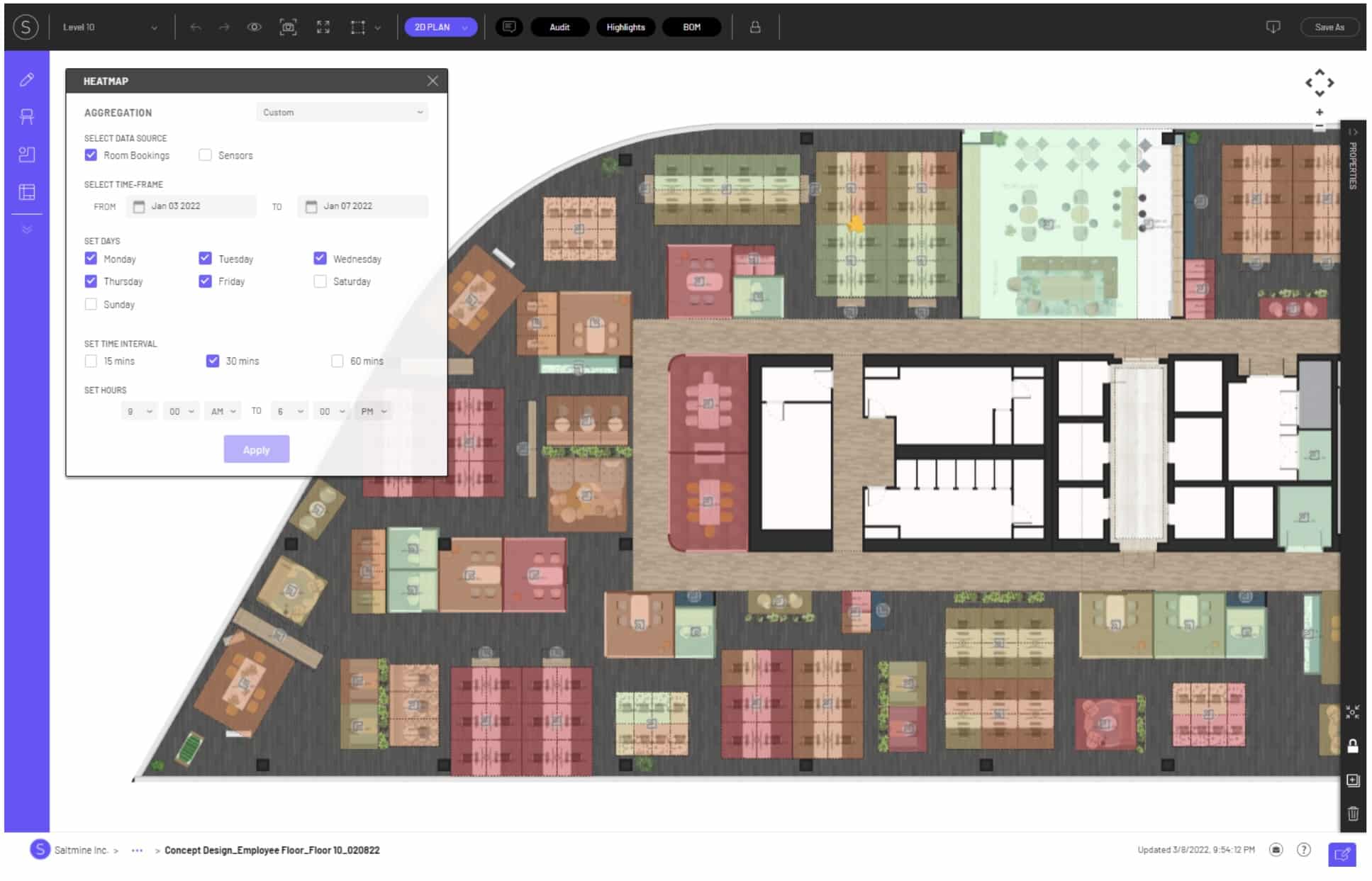Key takeaways from our webinar, “Informing Space: The Intersection of People and Data.”
A few weeks ago, Saltmine hosted a webinar with two workplace data and space planning experts from JLL.
Hannah Kumlin and Jay West are passionate about two things: leveraging data to enhance the employee’s office experience and getting the best ROI on office space for the business.

Both Hannah and Jay agree–in order to provide employees with engaging and productive office spaces, workplace and real estate teams need to know as much about employee behavior as possible. From occupancy sensors and badge swipes, to reservation system data and IP data–space planning must be rooted in the employee’s unique behavior and movement.
Behaviors vary and data reveals these crucial nuances and differences that indicate actual spatial needs. For Hannah and Jay, it’s all about looking at how people actually use space.
You’re going to need a lot of data points–that aren’t siloed
Properly informing office design decisions requires teams to understand how to leverage a multitude of amalgamated data points. In order to effectively leverage such a wide variety of data points, they can’t be siloed.
Siloed data often contains duplicate data points which can lead to discrepancies and confusion. For example, if maintenance calls a building one thing and the workplace team calls it another, it’ll be unnecessarily difficult to filter through “noisey” data to get the insights that matter.
Once your data points are unified it’s best to break down the various types of data you could capture into three main categories–physical movement, digital movement, and manual collection–to understand how each category’s mechanisms can feed into space planning.

1. Physical movement
Once scrubbed, badge data feeds into space planning by providing planners information pertaining to peak occupancy and helps teams identify which groups use the space most frequently.
Occupancy sensors allow space planners to understand how occupants are using space–this is useful for identifying underutilized opportunity areas and for ensuring things like collaborative spaces are the correct size for end user needs.
2. Digital movement
Reservation systems tell us which spaces are being booked and who is booking these spaces. This allows teams to identify underutilized space, compare how specific teams use space, etc.
Workplace ticketing systems provide occupants a streamlined way of contacting the workplace teams for feedback and requests. Employee surveys can also supplement this and provide a better understanding of the employee pulse.
Static IP data can be used to identify desk/resource usage. In Wi-Fi-connected office spaces, IP data can provide the number of devices that connect to a specific router over a period of time–giving planners high-level values for utilization.
3. Manual collection
Manually collected data allows planners to obtain counts of occupants-to-seats at specific points in time and is also useful in cases where names-to-seats need to be collected and verified via an IWMS/CAFM system.
Do you need all of these data points?
Maybe not. In the case of occupancy sensors, there are a lot of different options you can choose from (here’s our favorite). Maybe one works better for you and another works for a different company.
PropTech is hot right now; however, choosing the right workplace technology often depends on the size of your company, your space, and what you’re trying to achieve with the data.
For example, if you’re looking to analyze information regarding occupancy and how often space is being used, getting data via sensors will be very useful. From there, combining sensor data with the data from reservation systems and badge swipes will help paint a better picture of your occupancy research.
Employee feedback: The most important data point of them all
At the end of the day, the most important data point comes from simply asking what your people want out of a space. Sensors and other tech are important but investing in technology that better captures and collects actual employee feedback is crucial in informing space planning decisions.
Employee feedback is the foundation of everything. Start with a survey and ask your employees questions like:
- In one word, how does your workplace make you feel?
- Does the workplace inspire you to be productive?
- What values should a workplace display?
Ask questions without ulterior motives and allow employees to honestly give their opinion. You can have the highest tech office space around but if you haven’t genuinely asked about what your people want, you’ll likely end up with unoccupied space.
Connecting data points to space planning–i.e., the importance of data visualization
As noted by workplace innovator Simon Davis, “Workplace and real estate teams are getting big questions from the main players in corporations–making real estate portfolios and facilities management a high-priority piece of the business.”
The C-suite and leadership want to quickly get answers to questions like:
- What type of space do we need?
- Where does our current space stand?
- Do we have enough space or not enough?
- Are people actually using the space?
The list goes on. Trying to summarize all the various data points in excel files won’t connect with visual stakeholders who want answers to questions, fast. Data has to be visual–funneling data points into floorplans to help workplace and real estate teams tell the greater story of office utilization and engagement.

In order to use data to drive meaningful change to the workplace, you need to ensure your key stakeholders are on-board and workplace teams must be able to show them the data trends in a simple visual format. Heatmaps and dashboards are extremely useful tools for this as they equip teams with a simple, visual means to show the data.
A picture is easier to present than a spreadsheet.
Watch “Informing Space: The Intersection of People and Data” on demand
If this resonates and you want to learn more about how Hannah and Jay use workplace data to strategize and execute the offices of tomorrow, click the image below and check out our on demand webinar:
Enjoying our blog? Be sure to subscribe to stay up-to-date on Saltmine's original content with the form below!
 by
by 